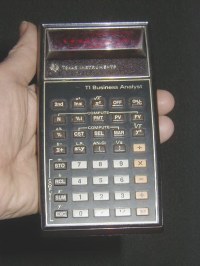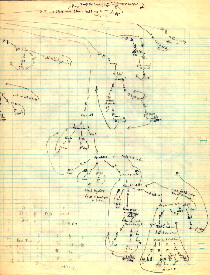The idea for the electronic spreadsheet came to me while I was a student at the Harvard Business School, working on my MBA degree, in the spring of 1978. Sitting in Aldrich Hall, room 108, I would daydream. "Imagine if my calculator had a ball in its back, like a mouse..." (I had seen a mouse previously, I think in a demonstration at a conference by Doug Engelbart, and maybe the Alto). And "...imagine if I had a heads-up display, like in a fighter plane, where I could see the virtual image hanging in the air in front of me. I could just move my mouse/keyboard calculator around on the table, punch in a few numbers, circle them to get a sum, do some calculations, and answer '10% will be fine!'" (10% was always the answer in those days when we couldn't do very complicated calculations...)
The summer of 1978, between first and second year of the MBA program, while riding a bike along a path on Martha's Vineyard, I decided that I wanted to pursue this idea and create a real product to sell after I graduated.
Baker Library at Harvard Business School, a picture of Dan in Aldrich 108 the first year from the HBS Yearbook (that was before he cut his long ponytail in the summer of 1978), a later photograph taken at the spot where Dan decided to create VisiCalc while bicycling on Martha's Vineyard
Here is a picture of me holding that calculator, a TI Business Analyst:
Dan's calculator from business school
Eventually, my vision became more realistic, and the heads-up display gave way to a normal screen. I tried prototyping the product's display screen in Basic on a video terminal connnected to the Business School's timesharing system in the spring of 1978. (Prototyping is a great way to force you to work out design problems.) That's when the desire for general placement of numbers, formula results, and text turned into rows and columns to give them human-friendly names. It also was when I decided upon the status line for displaying the formula and formatting behind the values being displayed.
The hope for using a mouse was replaced in the first personal computer prototype in the early fall of 1978 by the game paddle of the Apple ][. (This was a dial you could turn to move game objects back and forth, for example in "Pong".) You could move the cursor left or right, and then push the "fire" button, and then turning the paddle would move the cursor up and down. The R-C circuit or whatever in the Apple ][ was too sluggish and my pointing too imprecise to accurately position the cursor that way, so I switched to the two arrow keys of the Apple ][ keyboard (it only had 2) and used the space bar instead of the button to switch from horizontal movement to vertical.
I created that first PC prototype over a weekend on an Apple ][ I borrowed for the purpose from Dan Fylstra of Personal Software, later our publisher. I wrote it in Apple Basic. It did not scroll, yet, but it had the columns and rows and some arithmetic.
Comments in my work journal which shows that first prototype done on an Apple ][ was October 8, 1978. I kept a journal for most of the first few years of the company.
To design exactly how the program would work, I'd create state diagrams, showing what would happen when you pressed various keys. Here is a scan of a diagram that included many features, such as replication, help, etc. It was written on the back of a sheet of spreadsheet paper, hence the blue column and row lines. It about 17"x11", so it is scanned in two pieces, which I show here side by side:
State diagram design for spreadsheet, from winter 1978-1979
Here is a detail, showing some of the steps in early replicate. Note that you could point with the arrow keys ("<->") and space bar ("sp"), since this was for the Apple ][. "A-ZZ" referred to typing in the cell coordinate explicitly (e.g., "B14"). The Return key ("Ret") would get you some options for incrementing the value (which was not implemented in the first version):
Detail of Dan Bricklin's state diagram
Dan Fylstra, who had graduated the year before from Harvard Business School with an MBA and ran a personal computer software company out of his rented apartment, made a deal with my friend Bob Frankston and me. The basic deal was worked out during dinner at Joyce Chen's Restaurant in Cambridge, Massachusetts, near Fresh Pond. Bob and I would create the program, as authors, and Dan's company, Personal Software, would publish it. This "author/publisher" arrangement became popular in the PC industry. Personal Software would pay us 35.7% of their net gross for normal sales, and 50% for OEM (computer manufacturer) sales. This was based, as I remember it, on an initial price for the product equivalent to the TI calculator (like the one shown here) that was popular at Harvard ($35), less some costs, and then splitting the profit by some percentage. The OEM sale percentage reflected the difference in costs and other factors.
Notes from November 11, 1978, showing deal and requirements
These payment rates were high by publishing standards, but the founders of Personal Software were MBAs and computer people, and they saw the value of the product. Even with their sales of other products up to then of less than a million dollars, they were perhaps the largest publisher of software for personal computers at the time, helped by the popular MicroChess program written by one of their founders.
Bob and I decided to form a company under which to do business. Software Arts, Inc., was born, incorporating on January 2, 1979.
My homework paper
In the fall of 1978 I had a paper that I needed to write for my course in Advertising. The assignment was to write a private, few page paper that was to be in the form of a short descriptive business school case on an advertising management issue or 2-3 brief caselets on related facets of such an issue. Accompanying the descriptive material was to be our own comments/analysis of the case situation. I chose to do a 2-part case.
For my paper I chose to address the issue of advertising for the program I was developing, not yet called VisiCalc. The final name had not been chosen so I used "Calcu-ledger" as a placeholder, and the "case" is called "Calcu-ledger".
I needed to make the "case" revolve around advertising, so I made assertions about choices and beliefs at Personal Software and of mine that may or may not have actually been true. (For example, I was not the one tasked with creating their advertising as asserted in the paper.) However, the background material and other writings that I provided should be of interest from an historical perspective. It has narrative about the industry and copies of advertisements from the time.
My favorite quote is from the end of the paper (and I really must have felt this way):
A final word on the name "Calcu-ledger." Currently this appears to be the best name that I have been able to come up with. It has the unfortunate trait of not evoking the right image when heard out of context (ledger sounds too much like bookkeeping and accounting, and not easy use for non-accounting uses by non-accountants). Once the uses of the product are understood, though, its name becomes more appropriate (ledger is also a series of columns and rows). The uses are emphasized from the start in the ad, so I don't think that there will be many problems. Also, the name has a nice ring to it. Other names that I have thought of, such as "electronic spreadsheet" or "calcu-paper" don't sound right, or may not be understood by people, even after they know what it is (not everybody knows what a spreadsheet is, ledger is more common).
Patents
For information about why we didn't patent VisiCalc, see the article on Patents in the Writings Section this web site.











